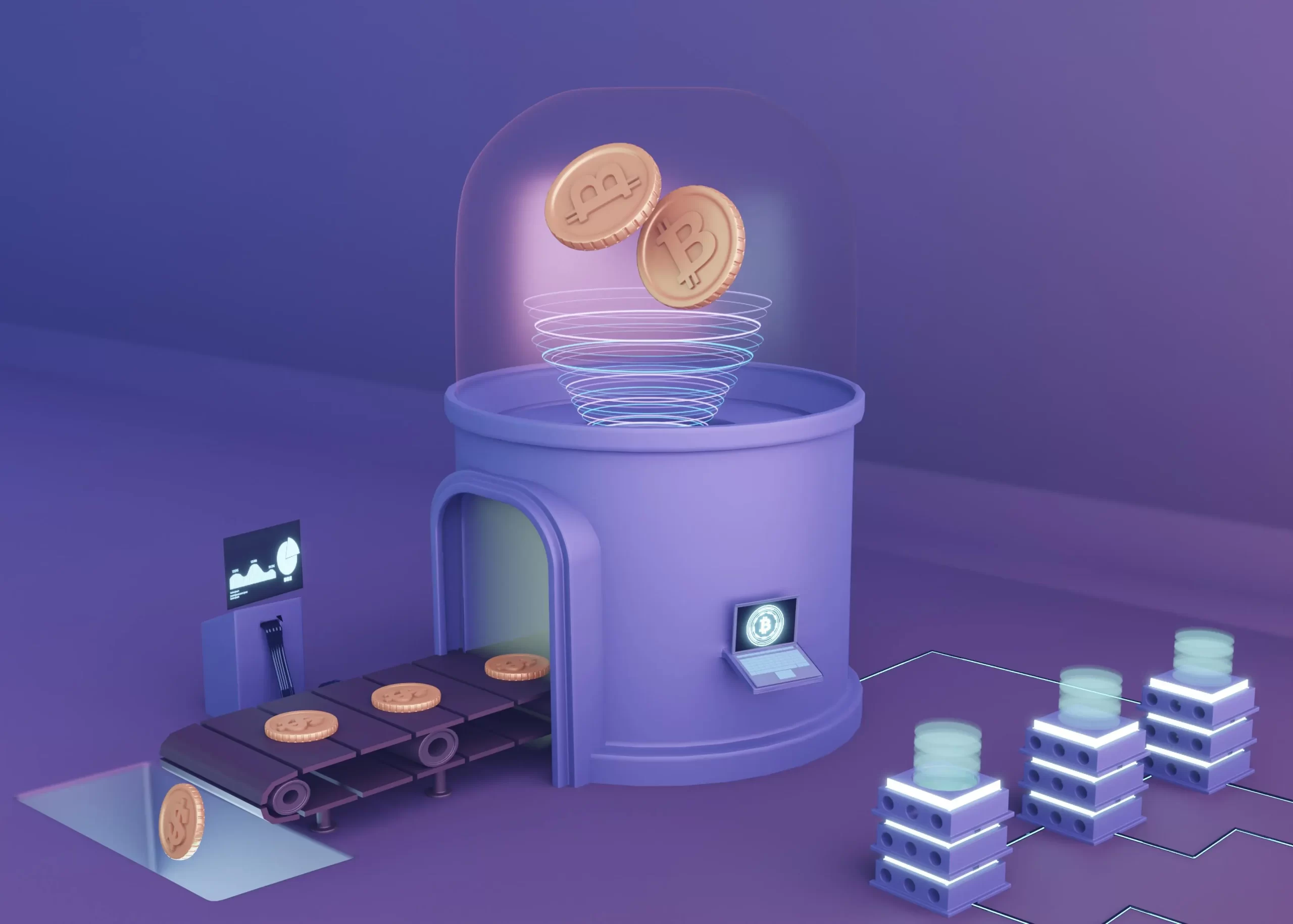Welcome to our comprehensive guide on how to mine Cryptocurrency. Whether you’re a beginner or an experienced miner, this article will provide the essential knowledge and step-by-step instructions to start cryptocurrency mining. We will explore the mining fundamentals, methods, equipment, and software needed for a successful mining operation. By the end of this guide, you’ll have a solid understanding of how to mine Cryptocurrency and the factors to consider for a profitable mining experience.
Table of Contents
ToggleKey Takeaways:
- Learn the basics of cryptocurrency mining.
- Understand the different types of mining.
- Choose the right Cryptocurrency and equipment.
- Set up a cryptocurrency wallet and configure your mining device.
- Join a mining pool for more consistent rewards.
What is cryptocurrency mining?
Cryptocurrency mining is a vital process that facilitates transaction verifications secures networks, and adds new coins to the blockchain. Miners utilize specialized hardware and software to solve complex mathematical problems that validate transactions.
This mining process ensures the network’s integrity and rewards miners with newly created coins. Cryptocurrency mining plays a crucial role in maintaining the decentralized nature of cryptocurrencies.
The Types of Cryptocurrency Mining
There are various methods of cryptocurrency mining, each with its advantages and requirements.
ASIC Mining
ASIC mining utilizes specialized hardware designed specifically for mining cryptocurrencies like Bitcoin. These Application-Specific Integrated Circuits (ASICs) are highly efficient and powerful, offering significant hashing power for mining operations.
GPU Mining
GPU mining utilizes graphics processing units to mine cryptocurrencies. This method offers more versatility than ASIC mining, as GPUs can be used for various mining algorithms. GPUs are particularly effective for mining cryptocurrencies that are resistant to ASICs.
CPU Mining
Though less potent than ASIC and GPU mining, CPU mining is still used for mining specific cryptocurrencies. Central Processing Units (CPUs) are the primary components of computers and can be used to mine less resource-intensive cryptocurrencies.
Mining Pools
Mining pools allow individual miners to combine their computing power and resources, increasing the chances of earning consistent rewards. By pooling their resources, miners can collectively solve the mining algorithms and share the rewards among the pool members based on their contributions.
Solo Mining
Solo mining involves mining independently, without joining a mining pool. While it offers the potential to earn the entire mining reward, it is more challenging to solve mining algorithms alone. Solo mining is often undertaken by experienced miners with significant computational resources.
Cloud Mining
Cloud mining allows users to rent mining power remotely without purchasing and maintaining mining hardware. Cloud mining service providers host the mining equipment and handle the associated maintenance, while users can access the mining power and receive a share of the mined coins.
How to mine crypto
To start mining Cryptocurrency, you need to follow several essential steps. This section will guide you through each step, from choosing a cryptocurrency to mine to setting up your mining equipment and configuring your device.
Choose a cryptocurrency to mine.
The first step in mining cryptocurrency is choosing which Cryptocurrency you want to mine. This decision should be based on factors such as your personal preferences, the profitability of the Cryptocurrency, and the mining equipment you have or plan to purchase.
Buy your mining equipment.
Once you’ve decided on a cryptocurrency to mine, you must acquire the necessary mining equipment. Depending on your chosen Cryptocurrency, this typically includes specialized hardware such as ASICs (Application-Specific Integrated Circuits) or GPUs (Graphics Processing Units). When purchasing your mining equipment, research and consider factors such as cost, power consumption, and mining capabilities.
Set up a cryptocurrency wallet.
Before mining, you must set up a cryptocurrency wallet to store and manage the coins you mine. A digital cryptocurrency wallet allows you to store, send, and receive your mined coins securely. Various wallets are available, each with its features and security measures. Choose a wallet compatible with the Cryptocurrency you’re mining and follow the setup instructions provided by the wallet provider.
Configure your mining device.
After setting up your wallet, it’s time to configure your mining device. This involves installing the necessary mining software and connecting your device to the pool. The mining software will vary depending on the cryptocurrency and mining equipment you’re using. Follow the instructions provided by the mining software and pool to configure your device for mining properly.
Join a mining pool.
Mining as part of a mining pool can increase your chances of earning consistent rewards. Joining a mining pool allows you to combine your mining resources with other miners, increasing the collective mining power. This improves the chances of successfully mining blocks and earning rewards. Research different mining pools, consider pool fees and payout systems, and choose a pool that aligns with your mining goals.
How to mine Cryptocurrency on a PC
If you prefer to mine Cryptocurrency on your PC, several software options allow you to utilize your computer’s processing power for mining. Research mining software compatible with your operating system and the Cryptocurrency you’re mining. Install the software and configure it to connect to your chosen mining pool.
How to mine Cryptocurrency on Android or iPhone
If you want to mine Cryptocurrency on your Android or iPhone device, mobile mining applications are available. These apps allow you to mine cryptocurrencies using your device’s processing power. However, it’s important to note that mobile mining may not be as profitable or efficient as mining on dedicated mining hardware.
How to mine Cryptocurrency for free
There are opportunities to mine Cryptocurrency for free, but it typically requires utilizing cloud mining services or participating in mining promotions and giveaways. Cloud mining involves renting mining power from a cloud mining provider. While it may not require upfront hardware costs, it’s essential to research the legitimacy and reputation of the cloud mining provider before investing.
How to mine Cryptocurrency on a laptop
Mining cryptocurrency on a laptop can be challenging due to the limited processing power and potential overheating issues. However, if you still want to mine on your computer, choose a cryptocurrency suitable for laptop mining. Additionally, take precautions to prevent overheating by ensuring proper ventilation and using cooling pads if necessary.
Is Cryptocurrency Mining Worth It?
Mining cryptocurrency can be a profitable venture, but carefully considering the costs and risks involved is essential. Several factors can affect mining profitability, including electricity costs, mining difficulty, and the price of the Cryptocurrency being mined.
While there are potential profits, it’s essential to calculate the potential returns before getting started. Online calculators can help determine mining profitability by considering hardware costs, electricity consumption, and hash rate.
Factors such as electricity costs, mining difficulty, and the price of the Cryptocurrency can impact profitability.
It’s essential to assess whether the potential profits outweigh the expenses. While mining can generate income, it’s crucial to factor in the costs of acquiring and maintaining mining equipment, electricity consumption, cooling systems, and other necessary expenses.
Additionally, the value of the Cryptocurrency being mined can fluctuate greatly, affecting potential profits. Market volatility and price fluctuations can make mining profitability unpredictable.
It’s also worth considering the constantly evolving landscape of cryptocurrency mining. Mining difficulty increases as more miners join the network, reducing individual mining rewards. This means that the same mining equipment may generate less profit over time.
Ultimately, the profitability of cryptocurrency mining depends on a variety of factors and varies from person to person. It’s important to carefully calculate the potential returns and perform a cost-benefit analysis before investing in mining equipment.
Mining cryptocurrency can be profitable, but it’s crucial to thoroughly assess the costs and risks involved to determine if it’s worth it for your specific circumstances.
Can you mine your Cryptocurrency?
While it is possible to create your own Cryptocurrency and mine it, the process is complex and requires technical knowledge. If you have ambitions to start your Cryptocurrency and become an active participant in the world of digital currencies, we will explore the steps involved to help you bring your vision to life.
Create your Cryptocurrency:
- Define the purpose and features: Determine your Cryptocurrency’s specific use case and unique features. Consider factors such as transaction speed, scalability, and privacy.
- Develop the blockchain: The blockchain is the backbone of any cryptocurrency. You must design and develop a blockchain that meets your project requirements. This involves programming and establishing consensus mechanisms.
- Set up the network: Once the blockchain is developed, you need to set up a network of nodes that will power the decentralized nature of your Cryptocurrency. These nodes will maintain the integrity of the blockchain and validate transactions.
- Create a cryptocurrency wallet: Like established cryptocurrencies, users need a secure wallet to store and manage their coins. Develop a user-friendly wallet with robust security measures to ensure the safety of your users’ funds.
- Mine your Cryptocurrency:
-
- Set up the mining software: You must create or modify existing mining software to be compatible with your Cryptocurrency. This software runs on mining hardware, allowing miners to solve complex mathematical problems and validate transactions.
- Deploy mining hardware: Choose the appropriate mining hardware based on the mining algorithm implemented in your Cryptocurrency. Depending on your network’s requirements, this can include ASICs, GPUs, or CPUs.
- Join a mining pool or mine solo: Decide whether you want to mine your Cryptocurrency independently or join a mining pool, where miners combine resources to increase their chances of earning rewards. Mining solo may take longer to generate coins, but you can keep the bonus.
- Start mining: Once your mining software is set up and the hardware is deployed, you can start mining your Cryptocurrency. The mining process involves solving mathematical puzzles to validate transactions and add new blocks to the blockchain.
Starting your own Cryptocurrency and mining can be a rewarding experience, but it requires careful planning, technical expertise, and a thorough understanding of the cryptocurrency ecosystem. Ensure you stay current with the latest developments in blockchain technology and security practices to create a successful and sustainable cryptocurrency.
Is Cryptocurrency mining legal?
Regarding the legality of cryptocurrency mining, it’s important to note that regulations and laws can vary significantly from country to country and even within different jurisdictions. Understanding the legal aspects of cryptocurrency mining is crucial to ensure compliance and avoid potential legal consequences.
Many countries allow cryptocurrency mining, considering it to be a legitimate activity. However, some nations have implemented specific regulations and licensing requirements for miners. These regulations often aim to address concerns related to energy consumption, taxation, and preventing illegal activities.
Cryptocurrency miners need to research and adhere to their respective countries’ mining regulations and laws. This includes obtaining any necessary licenses or permits and complying with reporting and taxation requirements. By doing so, miners can operate within the legal framework and avoid potential penalties or legal issues.
As the cryptocurrency landscape continues to evolve, staying updated with the latest developments in mining regulations is advisable. By remaining informed and compliant, miners can contribute to the stability and legitimacy of the cryptocurrency industry.
FAQ
How to mine Cryptocurrency?
Mining cryptocurrency involves verifying transactions, securing the network, and adding new coins to the blockchain. It requires specialized hardware and software to solve complex mathematical problems. We will provide a comprehensive guide on mining Cryptocurrency, covering everything from getting started to optimizing your mining process.
What is cryptocurrency mining?
Cryptocurrency mining is the process of validating transactions, ensuring network security, and generating new coins. Miners use specialized hardware and software to solve complex mathematical problems, verify the integrity of the network, and create new coins as a reward. Mining plays a vital role in maintaining the decentralized nature of cryptocurrencies.
What are the types of cryptocurrency mining?
There are various types of cryptocurrency mining, including ASIC mining, GPU mining, CPU mining, mining pools, solo mining, and cloud mining. Each method has its advantages and requirements. ASIC mining uses specialized hardware optimized for specific cryptocurrencies. GPU mining utilizes graphics processing units for increased versatility. CPU mining is still used for particular cryptocurrencies. Mining pools allow miners to combine resources for more consistent rewards, while solo mining involves mining independently. Cloud mining allows remote renting of mining power.
How to mine Cryptocurrency?
To begin mining Cryptocurrency, you must choose a cryptocurrency to mine, purchase the required mining equipment, set up a cryptocurrency wallet, configure your mining device, and consider joining a mining pool. We will provide step-by-step instructions on mining Cryptocurrency on various devices, including PCs, Android or iPhones, and laptops. Additionally, we will cover how to mine Cryptocurrency for free.
Is cryptocurrency mining profitable?
Mining cryptocurrency can be profitable, but it depends on factors such as electricity costs, mining difficulty, and the price of the Cryptocurrency. We will discuss the considerations for determining whether cryptocurrency mining is worthwhile. Additionally, we will provide insights on calculating mining profitability using online calculators.
Can you mine your Cryptocurrency?
It is possible to create and mine your Cryptocurrency, but the process is complex and requires technical knowledge. We will explore the steps in creating and mining your Cryptocurrency, including blockchain development, network setup, and the mining process. This section will provide an overview and insights into the feasibility of mining your Cryptocurrency.
Is cryptocurrency mining legal?
The legality of cryptocurrency mining varies by country and jurisdiction. We will examine the legal aspects of cryptocurrency mining, including regulations, licensing requirements, and potential legal issues. Understanding the legal implications before engaging in cryptocurrency mining is crucial to ensure compliance and avoid any possible legal consequences.








